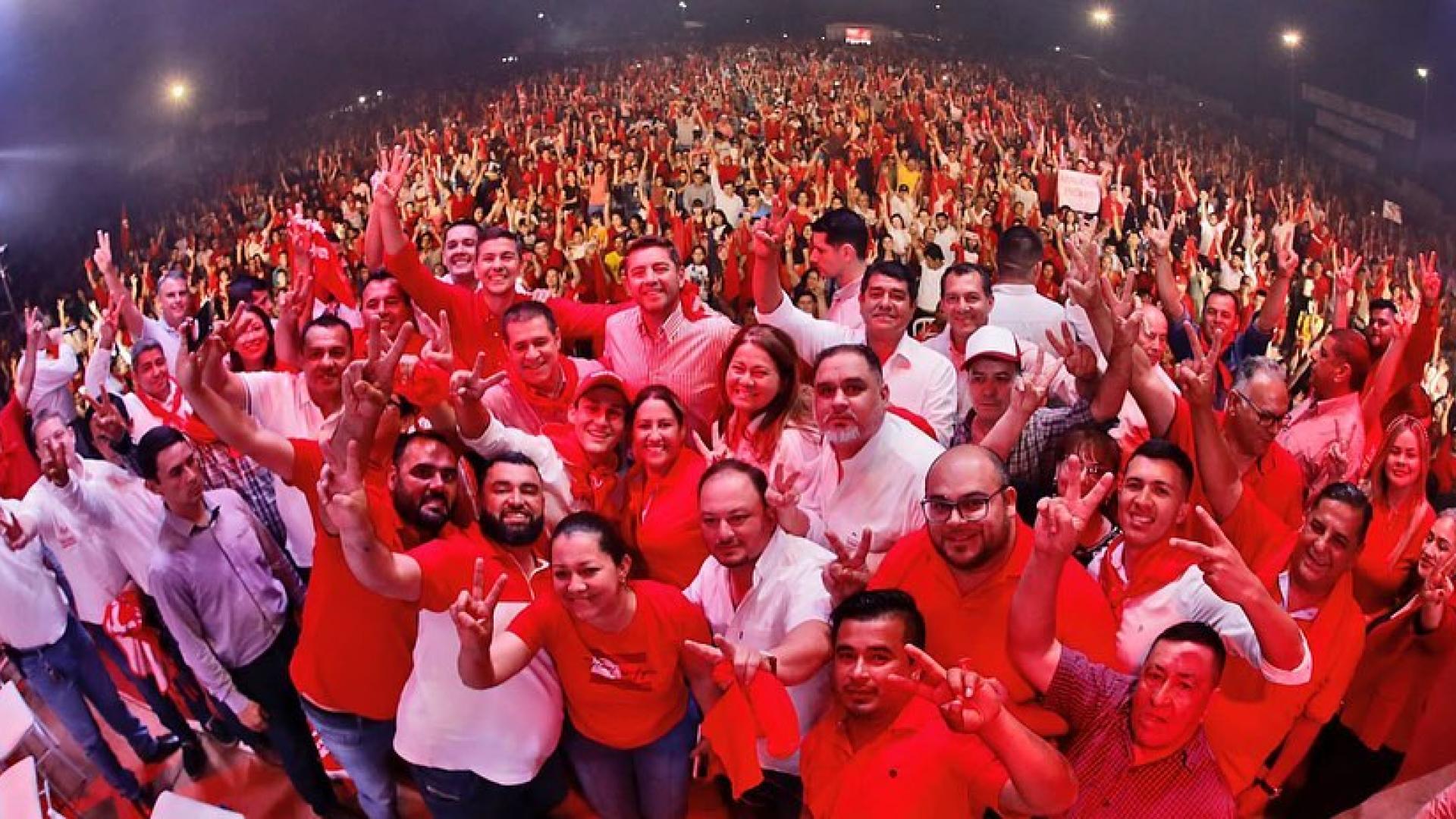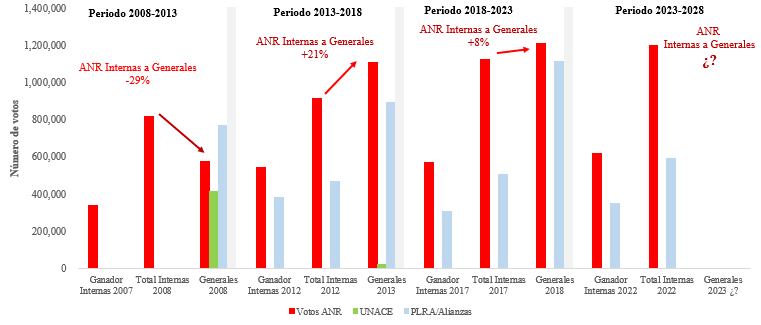
By José Tomás Sánchez
With the simultaneous political party primaries on December 18, 2022, an important step was taken on the road to the general elections of 2023. In these internal elections, the elections held in the Colorado Party, the National Concertation and the Liberal Party stood out. In this article I will highlight some lessons learned from the primaries of the Colorado Party, which presented some 73 thousand pre-candidatures for national, departmental and party elective offices.
In the first place, the ANR continued with its historical logic of internal “rebellion”. The resounding victory of Santiago Peña (List 2 Movimiento Honor Colorado) with 618,651 votes (51.6%), against the 526,061 votes (43.9%) of Arnoldo Wiens (List 3 Movimiento Fuerza Republicana) indicates that the partisan trend to favor internal oppositions to the ruling party persists. Like now, the colorado adversary to the government of Abdo Benítez won the internal elections, in 1992, 1997, 2002 and 2017, the candidate elected in the presidential internal elections was the rival option to the government in power. In 1992, there was an exception, Luis María Argaña won the internal elections, yet Wasmosy was awarded the victory in an acknowledged case of electoral fraud. Only in 2007 the ruling party candidate Blanca Ovelar was elected, in an election in which the contender Castiglioni denounced fraud. In 2022 the majority tendency of electing the opponent of the government in the internal party elections was seen again.
Figure 1 – Internal elections for the presidency of the Republic (ANR)

Source: Own elaboration with data from TSJE
A second lesson has to do with the internal dynamics of the ANR. In the elections for the presidency of the Governing Board, former President Horacio Cartes (50.5%, 605,917 votes) triumphed over the current President Mario Abdo Benítez (38.1%, 457,302 votes). This result suggests a shift in the party. With the election of Cartes, we could be seeing the consolidation of an internal movement (in this case the cartismo) within the party structure, by the hand of an ex-president, something unusual in the ANR. Especially considering that the multiple groups that gathered under the leadership of Abdo Benítez or Hugo Velázquez in Fuerza Republicana, could fade away after the result of December 18 and the end of the current government. Also remarkable was the fact that Abdo had 70 thousand votes less than Wiens, which shows the disengagement of President Abdo even from the ruling party’s own movement.
Figure 2 – Elections for the presidency of the Board of Governors (ANR)

Source: Own elaboration with data from TSJE
The previous point may indicate that for the first time in democracy, within the Colorado Party, one movement predominates over the others and that this predominance lasts. Since the fall of the dictatorship in 1989, the party has been divided into internal forces that have been constantly renewing themselves. In fact, this division already occurred in the second half of the 1980s, when the so-called “granite unity” that supported General Stroessner broke down and led to his downfall. Since then, internal factions developed in the party which could not dominate each other, in a dynamic of “correlation of weaknesses” in which no movement achieved internal dominance. Thus argañismo, wasmosismo, oviedismo, nicanorismo, cartismo and the (more blurred) abdismo followed one another. The rivalries of these factions manifested themselves very strongly, even violently in the 1990s, leading to serious problems of governance. But none of them solidified and no former president retained decisive political power once he left the Lopez chair. The former presidency became a sort of political “exile”, until Cartes came to show the opposite in the last internal elections. It remains to be seen if Cartesism will indeed be the leading force of the ANR.
Everything indicates that the elections of 2023 will resemble those of 2018 in that they will be close but will be different from those of 2018 in terms of the degree of polarization, which will probably intensify much more in 2023.
A third point is that “traditional” politics is still strong, with its usual sources of political power building. I mean that, at least for now, the internal elections with unblocked lists did not sweep away the leaderships of important political-partisan trajectory. Leaders such as Silvio Beto Ovelar (152,593 votes), Oscar Cachito Salomón (115,722), Juan Carlos Baruja (78,866) and Derlis Osorio (47,355) showed the effectiveness of usual strategies such as the articulation with local leaders, the use of party structures, the mobilization of resources, the strategic selection of territories in which to seek votes, as opposed to discursive positions detached from territorial work. This was seen, for example, in the limited capacity of candidates who sought to mount their campaigns on radical, nationalist, anti-gender and anti-international organizations messages (such as the discussion against the National Plan for Educational Transformation). Several candidates of Honor Colorado (the grouping that most insisted on this line) who followed this recipe of political construction, such as Enrique Riera (17,110 votes, #10 in his list) and José Ocampos (with 1,281 votes, #36), were left far behind with 3% and less than 1% of the votes. The exception was perhaps Lizarella Valiente, who had 6% of the votes (31,439), but she is associated with the structure of the mayor of Asunción. In sum, the “insiders” with traditional resources are still in full force in the internal politics of the Colorado party.
What do these results tell us about the ANR’s projections for the April 30 elections? To try and understand this, we can look at how much the ANR usually grows after its primaries on the way to the generals. Graph 3 shows some interesting points. First, since 2013 the ANR manages to aggregate in the general elections all the votes from the party internals, going far beyond the exclusive votes of the winner of the primaries. Only in 2008 it did not add all the votes from the internal elections. On that occasion, the ANR lost, between the internal and the general elections, 29% of the votes. It is to be presumed that in those elections the lost vote went to Lino César Oviedo, who founded his party UNACE as a detachment of the Colorado Party and in the 2008 elections obtained 22% of the votes (about 411 thousand). The idea that the Lugo-PLRA alliance won the 2008 elections with the Colorado vote is true, but because those votes went to Lino Oviedo, allowing Lugo’s 766 thousand votes to be enough to defeat Blanca Ovelar’s 573 thousand (ANR).
Graph 3 -Evolution between internal and general elections since 2008

Source: Own elaboration with data from TSJE and journalistic media.
In 2013, the ANR reversed the situation of 2008 and increased by 21% the votes between the internal and the general elections, adding 190 thousand votes that we could call “extra-party”. With that Horacio Cartes (ANR) defeated Efraín Alegre (PLRA-allies). The alliance led by the PLRA had increased 91% between its internal and the general elections, adding 423 thousand extra-party votes, more than doubling the ANR, but insufficient to win the elections. An interesting detail is that Lino Oviedo was a candidate for those general elections, he could still take part of the colorado votes. With his tragic accident months before the elections, in February 2013, Oviedo was out of the electoral competition and presumably the bulk of the UNACE vote returned to the ANR, which would be part of the 21% of the extra-party votes in the general elections.
In 2018 the ANR increased only 8% between the internal and the general elections, about 86 thousand votes. Once again, it was enough for Mario Abdo Benítez (ANR) with about 1,206,000 votes to defeat Efraín Alegre (PLRA-allies), who obtained 1,110,000 votes, adding 606 thousand extra-party votes, 7 times more than the ANR. The drop in the ANR’s extra-party votes between 2013 and 2018 may be due to several factors. The UNACE voter had already been absorbed by the ANR and did not add extra-party votes in 2018, or Mario Abdo Benítez had less influence outside the party compared to Cartes.
The data from the internal elections and the numbers of extra-party votes that the ANR obtained in the last general elections of 2018 leave several question marks for the general elections of 2023. The party’s electoral floor will likely be high and will again aggregate all the vote from the primaries (i.e., the ANR already has at least 1,199,050 votes). The ceiling is more uncertain: will the extra-party aggregate resemble the 21% of Cartes or the 8% of Mario Abdo? Peña has a profile more like Cartes, although there are no more UNACE voters to absorb. The Concertación, on the other hand, further expanded the previous PLRA alliance, and it remains to be seen what place Euclides Acevedo and Payo Cubas will have in April (will they absorb more ANR or Concertación votes?). It also remains to be seen if the unblocking of the lists for the legislative candidacies will attract more votes to the ANR, or if there will be a crossover vote. Everything indicates that the elections of 2023 will resemble those of 2018 in that they will be close but will be different from those of 2018 in terms of the degree of polarization, which will probably intensify much more in 2023.
Cover image: Santi Peña Press
